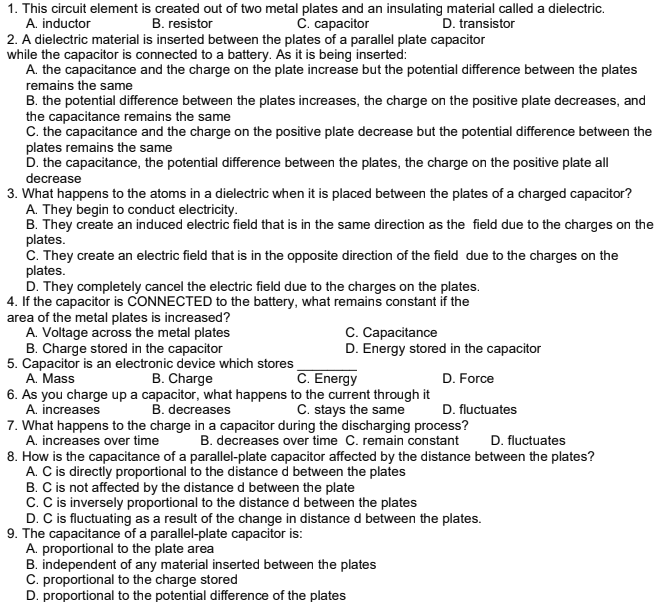1. This circuit element is created out of two metal plates and an insulating material called a dielectric. A. inductor Č. capacitor B. resistor D. transistor 2 A dielectric material is inserted between the plates of a parallel plate canacitor
1. This circuit element is created out of two metal plates and an insulating material called a dielectric. A. inductor Č. capacitor B. resistor D. transistor 2 A dielectric material is inserted between the plates of a parallel plate canacitor
Modern Physics
3rd Edition
ISBN:9781111794378
Author:Raymond A. Serway, Clement J. Moses, Curt A. Moyer
Publisher:Raymond A. Serway, Clement J. Moses, Curt A. Moyer
Chapter12: The Solid State
Section: Chapter Questions
Problem 23P
Related questions
Question

Transcribed Image Text:1. This circuit element is created out of two metal plates and an insulating material called a dielectric.
A. inductor
C. capacitor
B. resistor
D. transistor
2. A dielectric material is inserted between the plates of a parallel plate capacitor
while the capacitor is connected to a battery. As it is being inserted:
A. the capacitance and the charge on the plate increase but the potential difference between the plates
remains the same
B. the potential difference between the plates increases, the charge on the positive plate decreases, and
the capacitance remains the same
C. the capacitance and the charge on the positive plate decrease but the potential difference between the
plates remains the same
D. the capacitance, the potential difference between the plates, the charge on the positive plate all
decrease
3. What happens to the atoms in a dielectric when it is placed between the plates of a charged capacitor?
A. They begin to conduct electricity.
B. They create an induced electric field that is in the same direction as the field due to the charges on the
plates.
C. They create an electric field that is in the opposite direction of the field due to the charges on the
plates.
D. They completely cancel the electric field due to the charges on the plates.
4. If the capacitor is CONNECTED to the battery, what remains constant if the
area of the metal plates is increased?
A. Voltage across the metal plates
B. Charge stored in the capacitor
5. Capacitor is an electronic device which stores
A. Mass
6. As you charge up a capacitor, what happens to the current through it
A. increases
7. What happens to the charge in a capacitor during the discharging process?
A. increases over time
8. How is the capacitance of a parallel-plate capacitor affected by the distance between the plates?
A. C is directly proportional to the distance d between the plates
B. C is not affected by the distance d between the plate
C. C is inversely proportional to the distance d between the plates
D. C is fluctuating as a result of the change in distance d between the plates.
9. The capacitance of a parallel-plate capacitor is:
A. proportional to the plate area
B. independent of any material inserted between the plates
C. proportional to the charge stored
D. proportional to the potential difference of the plates
C. Capacitance
D. Energy stored in the capacitor
B. Charge
C. Energy
D. Force
B. decreases
C. stays the same
D. fluctuates
B. decreases over time C. remain constant
D. fluctuates
Expert Solution
This question has been solved!
Explore an expertly crafted, step-by-step solution for a thorough understanding of key concepts.
This is a popular solution!
Trending now
This is a popular solution!
Step by step
Solved in 2 steps

Knowledge Booster
Learn more about
Need a deep-dive on the concept behind this application? Look no further. Learn more about this topic, physics and related others by exploring similar questions and additional content below.Recommended textbooks for you

Modern Physics
Physics
ISBN:
9781111794378
Author:
Raymond A. Serway, Clement J. Moses, Curt A. Moyer
Publisher:
Cengage Learning

College Physics
Physics
ISBN:
9781285737027
Author:
Raymond A. Serway, Chris Vuille
Publisher:
Cengage Learning

University Physics Volume 3
Physics
ISBN:
9781938168185
Author:
William Moebs, Jeff Sanny
Publisher:
OpenStax

Modern Physics
Physics
ISBN:
9781111794378
Author:
Raymond A. Serway, Clement J. Moses, Curt A. Moyer
Publisher:
Cengage Learning

College Physics
Physics
ISBN:
9781285737027
Author:
Raymond A. Serway, Chris Vuille
Publisher:
Cengage Learning

University Physics Volume 3
Physics
ISBN:
9781938168185
Author:
William Moebs, Jeff Sanny
Publisher:
OpenStax

College Physics
Physics
ISBN:
9781938168000
Author:
Paul Peter Urone, Roger Hinrichs
Publisher:
OpenStax College


College Physics
Physics
ISBN:
9781305952300
Author:
Raymond A. Serway, Chris Vuille
Publisher:
Cengage Learning